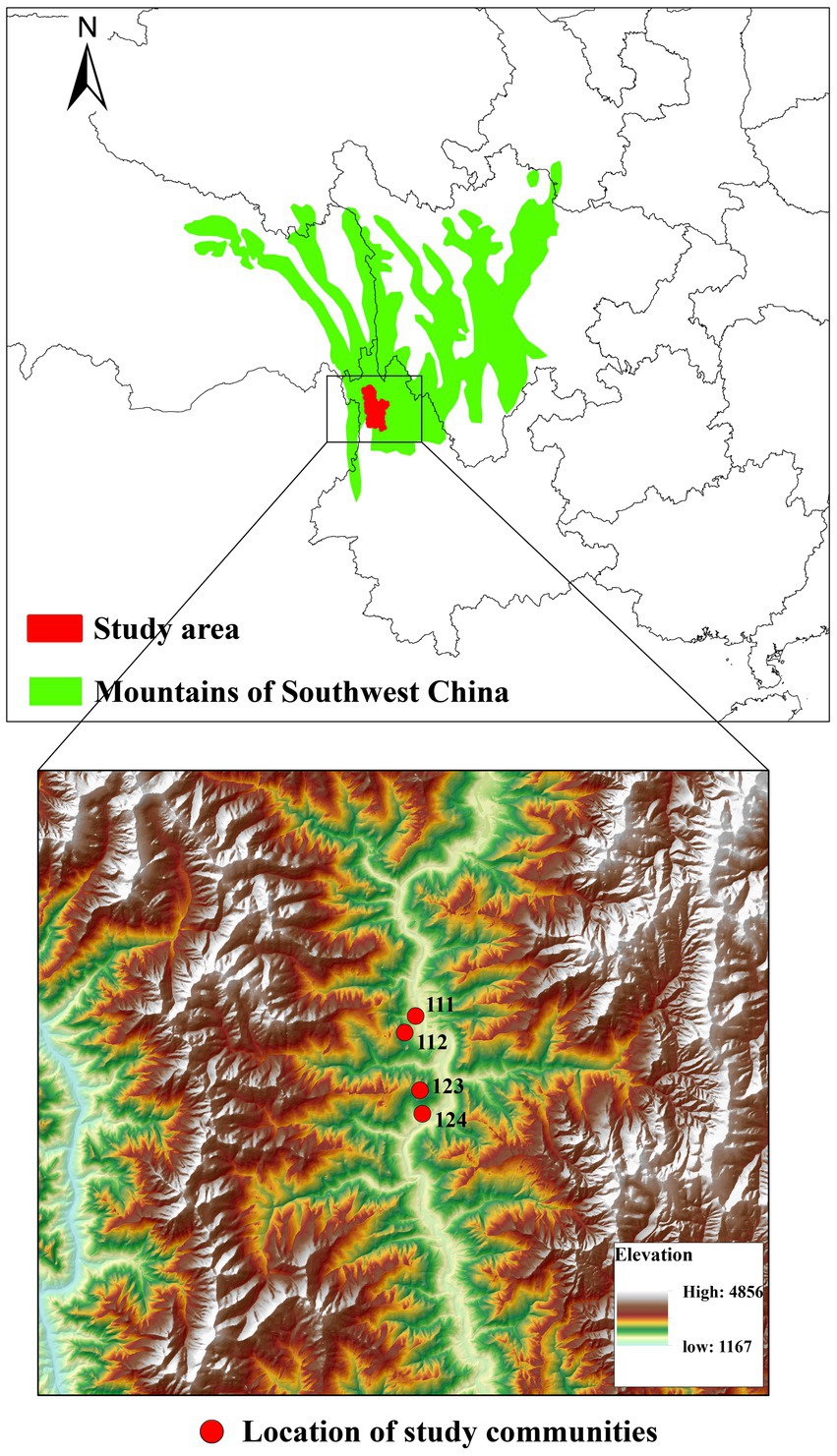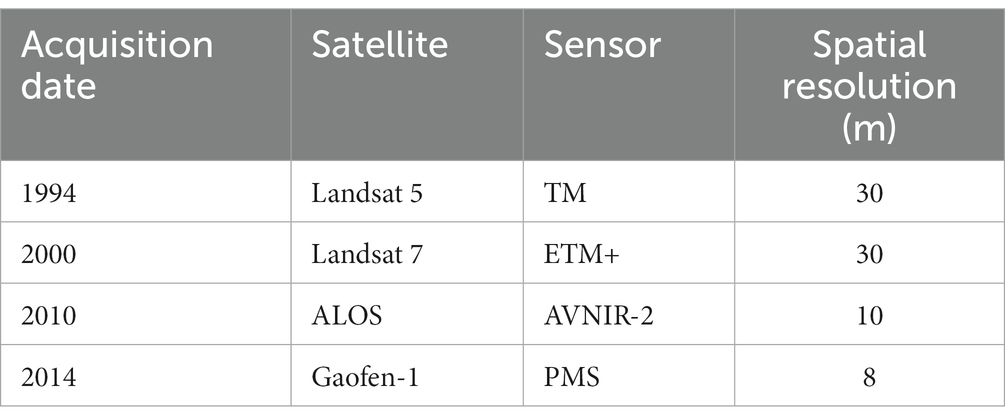- 1School of Ecology and Environmental Sciences and Yunnan, Key Laboratory for Plateau Mountain Ecology and Restoration of Degraded Environments, Yunnan University, Kunming, China
- 2CAS Key Laboratory for Plant Diversity and Biogeography of East Asia, Kunming Institute of Botany, Chinese Academy of Sciences, Kunming, China
- 3School of Life Sciences, Yunnan University, Kunming, China
China’s recent collective forest tenure reform (CFTR) aims to improve forest conditions by devolution of forest management rights from community collectives to individual households. Studies reveal substantial local variation in CFTR implementation, but the ecological effects and underlying mechanism have received little attention. Our study focused on community-managed forests and household-managed forests in four communities located in the mountains of Southwest China. The objective was to investigate the relationship between CFTR and forest conditions at the local scale. We employed a combination of remote sensing technology, field forest observations and socioeconomic surveys to gather data for analysis. The results showed that the forest cover change trends of collective forests and household forests in each community were consistent from 1994 to 2014. There was no significant relationship between CFTR implementation and local-level differences in species diversity and soil fertility in forests. The aboveground biomass of collective forests was significantly higher than that of household forests. Differentiated access and use, low compensation amounts, and loose payment terms jointly affected CFTR’s effectiveness to improve local-scale forest conditions in the study area. Attempts to formalize forest tenure rights must be flexible enough and adapted to the local environment so that changes induced by the CFTR can improve local access to forest resources and its benefits.
1. Introduction
Forests are the most important terrestrial ecosystems and play an important role in sustainable development through climate change mitigation, critical ecosystem services, human livelihood security and biodiversity conservation (Timko et al., 2018; Katila et al., 2020a). Global forests are experiencing severe deforestation and degradation (Riitters et al., 2016; Fischer et al., 2021; Morreale et al., 2021). To call attention to the quality of forests, the term “forest conditions” is proposed (Davis et al., 2001). It is used not only to describe the changes in forest cover but also to describe forest structure, diversity, biomass and even health (Yin, 2016; Huang, 2019; Ekanayake et al., 2020). The decline in forest conditions continues at an unsustainable rate despite growing international agreements to protect forests (Xu, 2011; Curtis et al., 2018; Li et al., 2020). Unclear property rights and poor management of land use are key factors in forest degradation (Balooni et al., 2007; Dai et al., 2012; Rendenieks et al., 2015; Lawry et al., 2017; Schürmann et al., 2020). Forest tenure decides who can utilize which resources, under what conditions, in what manner and for how long, and who has the right to transfer rights to others (Larson et al., 2010). Since the mid-1980s, forest tenure reforms have been widely implemented worldwide. Devolution has become a prominent feature of forest governance, with more than a quarter of forests in developing countries owned by communities or allocated to households in the community (Larson et al., 2010). Currently, nearly half of Europe’s forests (excluding the Russian Federation) are privately owned, providing a range of valuable ecosystem services to society (Lawry et al., 2017; Nichiforel et al., 2018). A more complex vertical canopy structure and higher tree species richness are characteristic of private forests in northern Latvia (Rendenieks et al., 2015). It is believed that devolving control of forest resources from state to communities or individual households would lead to more effective, accountable, equitable and flexible effects (Yin, 2016). However, there is still no definite or strong evidence to show which specific ownership types would ensure the improvement of forest conditions in certain cases (Chen and Innes, 2013).
The advantages of transferring forest tenure from state to community collectives are a major concern in the available literature, while devolution of forests through individualization has received little attention (Robinson et al., 2014; Blackman and Veit, 2018; Robinson et al., 2018; He et al., 2020). China has the largest share of the world’s community collective forests, accounting for more than 60% of the total community forest area in the Asia-Pacific region (Sikor et al., 2013). For a long time, China’s collective forests have been faced with the dilemma of indiscriminate deforestation and generally low enthusiasm of households for forest management and conservation, resulting in low stand quality, growth rate and ecosystem function (Chen and Innes, 2013; Yin et al., 2013; Hou et al., 2019; Xu and Hyde, 2019). In efforts to stanch deforestation and propel forest transitions, the Chinese government has invested heavily in the improvement of the national forest tenure system through collective forest tenure reform (CFTR) to restructure the property rights of forests belonging to rural communities (Liu and Ravenscroft, 2016; Liu et al., 2017a). CFTR began in the mid-1980s with the “Three Fixes”: stabilization of forest tenure, demarcation of responsibility hills and freehold hills (Liu et al., 2017b; Xu and Jiang, 2019). In 2003, the central government implemented a new round of CFTR with “clear property rights and flexible management” as the core content. It focuses on the decollectivization of collectively owned community forests, similar to the household contract responsibility system that individualizes farmland tenure. State authorities aim to establish households as the subject of management by clarifying and redistributing rights to use existing community collective forestland and tree ownership to individual households. It is expected that the clarification of property rights and implementation of incentives and subsidies will lead fairly straightforwardly to desired changes in forest conditions (Robinson et al., 2014; He and Sikor, 2017; He et al., 2020).
Studies to assess the effectiveness of CFTR are centered on analyzing participants’ subjective evaluation and household behavior or income, ignoring that the ultimate goal is to improve forest conditions (Xu et al., 2010; Holden et al., 2011; Xie et al., 2013; Yi et al., 2014; Xu and Hyde, 2019; Xu and Jiang, 2019). According to data from the Eighth National Forest Resources Inventory (2009–2013), the area and volume of collective forests in China increased by 18.57 and 44.69% respectively, compared with the Sixth National Forest Resources Inventory (1999–2003). The government claims that the growth of collective forest resources is attributed to CFTR implementation. However, some empirical studies note that although CFTR alleviates the timber shortage in China, it also reduces forest stock and has adverse effects on biodiversity and carbon sequestration (Zhang et al., 2012). He et al. (2014) also found that due to conflicts between formal and actual tenure and differences in local governance, the actual results of this reform at the local scale seemed to have diverged sharply from the government’s intentions. CFTR is a top-down policy. The substantial local variation in implementation probably led to great uncertainty about the effect of CFTR on forest conditions (Yin, 2016; Xu et al., 2017; Zinda and Zhang, 2018; He et al., 2020). Furthermore, analyses of coupled devolution systems and ecological effects often rely on subjective or perceived assessments of forest cover (e.g., good, medium and poor) or changes in forest dynamics over time (e.g., improvement, constant and deterioration), while forest structure, diversity, biomass and soil fertility are rarely considered (Yin, 2016). However, even with improved remote sensing techniques, these standards are inherently difficult to measure, thus the canopy structures and biomes that make up forests and support human use are ignored (Zinda and Zhang, 2018). Without set goals, these aspects evade measurement. Therefore, it is important to explore the relationship between the CFTR and comprehensive forest conditions at the local scale using a combination of remote sensing data and field surveys.
Mountains in Southwest China are a global biodiversity hotspot and the second largest natural forest region in the country. Forests are vital to the livelihoods of marginalized groups, including the poor, women and ethnic minorities. Over the past 30 years, the region has implemented the Returning Farmland to Forest Program (RFFP) and CFTR to improve forest conditions and local livelihoods. Our previous study found that RFFP had a limited effect on increasing forest cover and improving forest ecological quality at the community level in the region (Li et al., 2019, 2020, 2022). The contiguous expansion of large-scale monocultures coupled with economic and population pressures threatens natural forest quality and landscape fragmentation (Frayer et al., 2014; Hua et al., 2018a; Liu et al., 2019). It is necessary to examine the effectiveness of CFTR on forest conditions in this area. Mountains of Southwest China have undergone major reforms in forest tenure rights, with central policy statements prioritizing the allocation of community collective forest tenure rights among households to facilitate effective management (Brown, 2020). Most collective forest management and use rights have been devolved from community collectives to individual households. This area maximizes the variation in CFTR and is thus suitable for studying the effects of CFTR on forest conditions at the local scale.
To examine the relationship between CFTR and forest conditions at the local scale, we linked field forest observations and socioeconomic surveys with multiseries remote sensing images. This approach enabled us to address the following scientific questions: (1) Do the patterns of forest cover change in collective forests and household forests exhibit similarities or differences over the past 20 years? (2) Are there significant differences in species composition, diversity, aboveground biomass, and soil fertility between collective forests and household forests? (3) What is the underlying mechanism by which CFTR affect forest conditions at the local scale? This study will help provide valuable insights for the development of more sustainable and ecological forest management models and contribute to the global experience in forest tenure reform and community forestry development.
2. Materials and methods
2.1. Study region
Weixi Lisu Autonomous County is located in northwestern Yunnan Province and is the core area of the mountains of Southwest China (Figure 1). The elevation difference in the county is more than 3,000 m, and the undulating mountain and valley landforms have nurtured a rich biodiversity. There are more than 20 ethnic minorities living in the region, and forests are the most important source of firewood, timber and fodder for households. In the process of formally allocating forest tenure, the region has maintained various informal forest tenure system arrangements. From 1956 to 1982, collective forests in the study area were owned and managed by community collectives. In the early 1980s, the central government promulgated the “Three Fixes,” and collectively held forests began to be devoluted to individual households. In 2009, a new round of CFTR was conducted, and the boundaries of household forests were demarcated by rock landscapes, streams and ridges. Most of the collective forests were allocated among households, while the rest continued to be managed by the community collectives. We selected four village communities in the northern region of Weixi County as our subjects (Figure 1). The principle of selecting communities is to maximize the variation in CFTR. Collective forests and household forests co-occurred in each community. Each household in the four communities was given a household forest area proportional to the family size. The collective forest areas of communities 111, 112, 123 and 124 were 19.36 hm2, 27.64 hm2, 3.31 hm2 and 0.87 hm2, respectively. The household forest areas were 24.49 hm2, 12.32 hm2, 39.30 hm2 and 19.77 hm2, respectively.
2.2. Data collection
To address the scientific questions raised above, we collected data on CFTR implementation options, forest cover change, forest conditions and household livelihood strategies in the study area.
2.2.1. Interview and participatory mapping
To obtain information on forest resource utilization and participation in CFTR of households in the study area, we used household questionnaires and focus group discussions to collect socioeconomic data from July to August 2014. We surveyed all households in each community on demographics, livelihood activities, resource use, participation in key forestry projects, and perceptions of community institutions. The authors together with 11 trained enumerators conducted interviews with an adult member from each present household in every community visited. The questionnaire was conducted in Mandarin Chinese. A total of 104 valid questionnaires were collected from the four communities. In the subsequent analysis, all mames of places and individuals are pseudonyms, and all communities are represented by numeric codes. Moreover, with the assistance of local officials, we selected 5–6 farmers of different genders and ages in each community to conduct focus group discussions on forest use. Focus groups included mapping work by the group participants to identify areas on the map of forests belonging to different tenure types. The resulting sketch maps were used to create GIS layers to determine the geographical boundaries and extent of collective forests and household forests. The focus group also included interviews on changes in forest ownership, household livelihoods and community rules and regulations. Information on the use of current and historic forests helps to characterize community institutions and project implementation processes. We used the data obtained to determine how and to what extent households and communities were involved in forest management.
2.2.2. Remote sensing imagery
Field survey data can mirror phenological information and vegetation changes, but field station data may have monitoring interruptions and spatial discontinuities (Zhang et al., 2021). The normalized difference vegetation index (NDVI) from remotely sensed data can be used as an alternative, as it has many advantages in assessing changes in vegetation and phenology (Liu et al., 2022). These advantages include highly sensitive plant detection, high comparability, broad spatiotemporal cover and low noise (Guo et al., 2018). The NDVI is a popular technique for identifying and estimating forest area (Xue and Su, 2017). In this study, the NDVI was used to analyze the macroscopic characteristics of forest cover changes in collective forests and household forests in the study area from the 1990s to the present.
Considering the availability of remote sensing data in the study area, we extracted bands from Landsat 5 TM, Landsat 7 ETM, Advanced Land Observation Satellite (ALOS) and Gaofen-1 Satellite data (Table 1). The spatial resolutions of the four phases of image data were 30 m, 30 m, 10 m, and 8 m, respectively. Atmospheric corrections were performed on all four images before using the data to detect changes in forest cover. For each atmosphere-corrected image, a cloud mask method called CF-mask was used to remove clouds, cloud shadows and snow pixels to obtain effective observation data. The method is suited to prepare sensing data for detecting NDVI dynamics (Huang et al., 2021). Then, the NDVI was extracted for each valid observation. Prior to NDVI change analysis, four land cover maps were resampled using the 30-m resolution map of 1994 to improve data integration for change detection analysis. The geographic boundary data of collective forests and household forests in each community were obtained via focus groups with participatory mapping exercises. We created a polygon layer representing the boundaries of each community collective forest and household forest, digitized from paper maps and manually geo-corrected with reference to 2010 ALOS imagery. We used this layer to mask the NDVI raster for each community as the unit of comparison in the analysis. The average method is used to extract the NDVI data of all pixel time series in each community collective forests and household forests in the study area one by one.
2.2.3. Forest condition measures
Focusing on the impact of different forest management methods in CFTR on forest conditions, we measured the composition, structure, diversity, biomass and soil fertility of collective forests and household forests in each village community through field forest observations. To minimize the influence of confounding biophysical factors, all the plots were situated on the eastern side of the west bank of the Lancang River basin, predominantly facing east or southeast. The four communities we selected, one at low elevation, one at high elevation and two at medium elevation, to illustrate the differences between riverside and riparian upslope communities (Figure 1). This sample exemplifies the logic of maximum variation sampling, capturing a wide range of variation within a population to ensure a comprehensive representation in a limited sample. We recorded the physical characteristics of forest communities, small landforms and the surrounding environment, prominent ecological phenomena and human disturbance in each plot. Based on forest management types and a set of biophysical criteria designed to maximize comparability across sites, we systematically selected plots in the study area. At each site, we marked a group of plots. We selected household forests of 5–6 households in each community to set up plots. There were six plots in each household’s forests, and each plot size was also 10 m × 10 m. The subsets of households were selected based on wealth rankings or criteria derived from questionnaire surveys of project participants. We then selected a representative site in each village community’s collective forests. At each site, six plots were set up, each with a size of 10 m × 10 m. The species, height, cover, diameter at breast height (DBH), number of plants in the tree layer and the species, height, cover, crown diameter (CD) and number of plants in the shrub layer were investigated in each plot. Four 1 m × 1 m herbaceous plots were set up in each 10 m × 10 m plot, and the species, height, cover and number of plants in the herb layer were recorded. A total of 24 collective forest plots and 96 household forest plots were surveyed in four village communities during July and August 2014.
After removing forest litter from the soil surface, the soil profiles were excavated at five selected points in each plot in an S-shaped manner, and samples were taken from three deep layers (0–20 cm, 20–40 cm, and 40–60 cm). Then, we mixed the three layers of soil in each plot to comprise a 1-kg test sample. The samples were sealed in self-sealing bags and taken to the laboratory for testing of physical and chemical properties. We selected pH, hydrolyzable nitrogen, total nitrogen, soil organic matter, available phosphorus, available potassium, total potassium, and total phosphorus to represent the soil fertility of the forest community. For details of the specific measurement methods for each indicator, see Li et al. (2020). A total of 24 collective forest soil samples and 96 household forest soil samples were collected from four village communities.
2.3. Data analysis
2.3.1. NDVI extraction
The NDVI was extracted from remote sensing images by the ratio of the near-infrared band minus the red band to the near-infrared band plus the red band (Rahman et al., 2004). NDVI values range from −1 to +1. NDVI values close to +1 indicate the highest forest cover, while negative NDVI values indicate non-vegetated areas. Bands 4 and 3 of Landsat 5 TM, Landsat 7 ETM, ALOS and Gaofen-1 are the infrared band and near-infrared band. The formula is as follows:
2.3.2. Forest community composition
We selected the Jaccard similarity coefficient (J) and importance value (IV) to measure the composition of forest communities. Both J and IV are important quantitative indicators of forest communities. The former is used to compare the similarity of species composition between different communities, and the latter is often used to compare the importance of a species between different communities. The formula is as follows (Krebs, 1999):
where Dr is the relative abundance, Rc is the relative cover, and Fr is the relative frequency.
2.3.3. Forest species diversity
The Shannon–Wiener Wiener index (H′) and Simpson index (D) were selected to measure the species diversity of forest communities. The diversity index is a mathematical measure of species diversity in a given community. The two indices capture different aspects of diversity and provide complementary information. The formula is as follows (Gotelli and Chao, 2013):
where S is the total number of individuals found in the plot and Pi is the relative abundance of the i-th species.
2.3.4. Forest aboveground biomass
Forest aboveground biomass is the embodiment of the carbon sequestration capacity of forest ecosystems and an important indicator for measuring forest conditions. The tree biomass equation based on allometric growth theory has the advantages of accuracy, efficiency and simplicity. It is the most commonly used method to estimate tree and forest biomass at various spatial–temporal scales (Paul et al., 2016; Luo et al., 2020). A tree biomass equation is a quantitative relationship between tree biomass and one or more simple, readily available tree measurement variables, such as DBH/CD and height. It provides a general and reliable method for estimating the biomass and net productivity of forest ecosystems. In the late 1970s, China began to study measuring tree biomass and establishing biomass equations (Pan et al., 1978). Subsequently, many studies are extended to almost all climatic zones and forest types in China (Luo et al., 2014). Pinus yunnanensis is an endemic species in the mountains of Southwest China, and it is also an absolutely dominant tree species in the tree layer of the forest communities in our study area. Considering the geographical location of the study area, we selected the single-tree biomass equation of P. yunnanensis in northwest Yunnan constructed by Liu (2015) to estimate the biomass of the tree layer in each plot. Quercus acutissima is the subdominant species in the tree layer, and we followed the model of Xu et al. (2011) to estimate its individual biomass. Coriaria nepalensis, Rhododendron simsii, Vaccinium bracteatum and Viburnum cylindricum are dominant species in the shrub layer. We selected the individual biomass equation of the above shrub species constructed by Luan (1989), Zhang and Chen (2006), and Li (2010). Finally, the aboveground biomass of each plot was obtained by multiplying the single-tree biomass by the number of trees. The biomass calculation equations of the different tree species are as follows:
P. yunnanensis: W = 0.0479(D2H)0.9638
Q. acutissima: W = 9.3540 × 10−4D2.0825H2.1154
Other mixed tree species: W = 0.0460(D2H)0.6530
C. nepalensis: W = 66.1690 (C2H)0.0840
R. simsii: W = 1.4337(C2H)0.8643
Other mixed shrub species: W = −1.9560 + 11.8320C – 0.2800C2
where W is biomass, C is crown diameter, D is diameter at breast height, and H is height.
Student’s t test was used to assess whether there were significant differences in diversity, biomass and soil fertility between collective forests and household forests. Case comparative and qualitative-inductive methods were used to compare patterns of community institutions and community leader behavior behind the implementation of CFTR choices. We also used inferential statistics complemented by qualitative data to compare household livelihoods across communities. Identifying how community institutions distribute resource use and using field measures and remote sensing data to measure the environmental impacts of forest use enable us to assess patterns across communities, with the goal of causal explanation of variation in forest conditions.
3. Results
3.1. Forest cover change
From 1994 to 2014, the NDVI change trends between collective forests and household forests in each village community were consistent (Figure 2). The NDVI of collective forests and household forests continued to increase in three village communities during the study period but not in village community 123. There was no significant difference in the NDVI between them in 1994, 2000, 2010 or 2014 (Table 2). These results show that both community-managed forests and household-managed forests have gradually recovered over the past 30 years, showing a trend of increasing area.
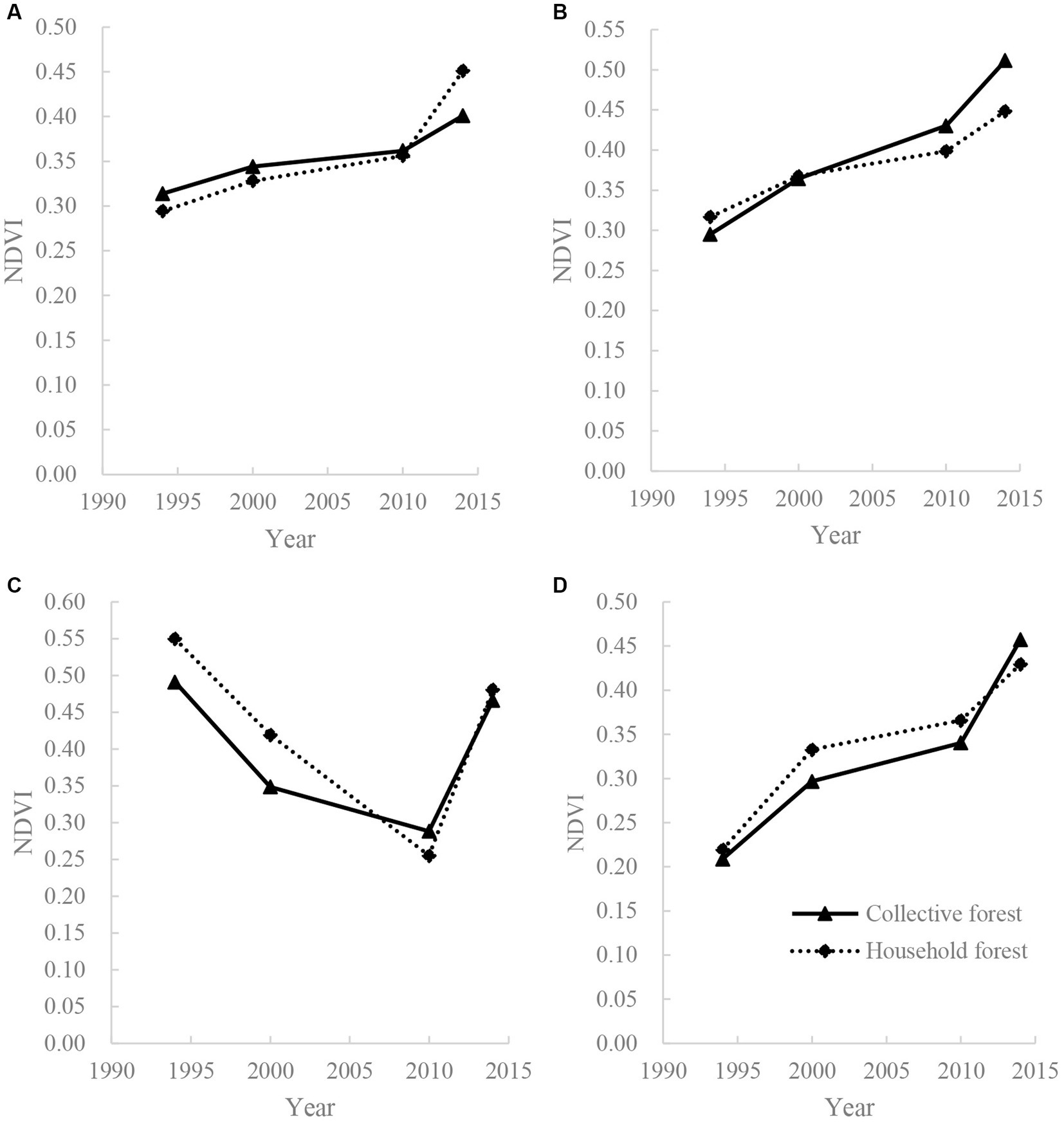
Figure 2. NDVI change trends of collective forests and household forests in four communities in the study area. (A) 112; (B) 111; (C) 123; (D) 124.
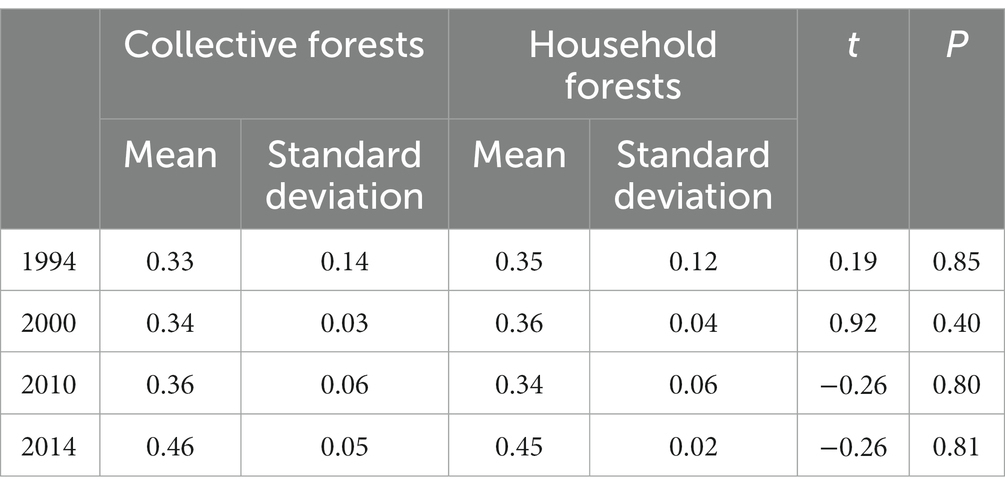
Table 2. Comparison of NDVI between collective forests and household forests in 1994–2014 (Samples sizes are n = 4 and 4, respectively, for collective forests and household forests groups).
3.2. Species composition and diversity
Both collective forests and household forests have evident vertical stratification characteristics. Their species composition was similar in the tree layer, shrub layer and herbaceous layer. P. yunnanensis was the dominant and common species in the tree layer (Table 3). There were no significant differences in the Shannon–Wiener diversity index and Simpson diversity index of the tree layer, shrub layer and herbaceous layer between the collective forests and household forests at either the village community level or plot level (Figures 3, 4). Therefore, at the local scale, CFTR likely did not play a significant role in forest species composition and diversity in the study area.
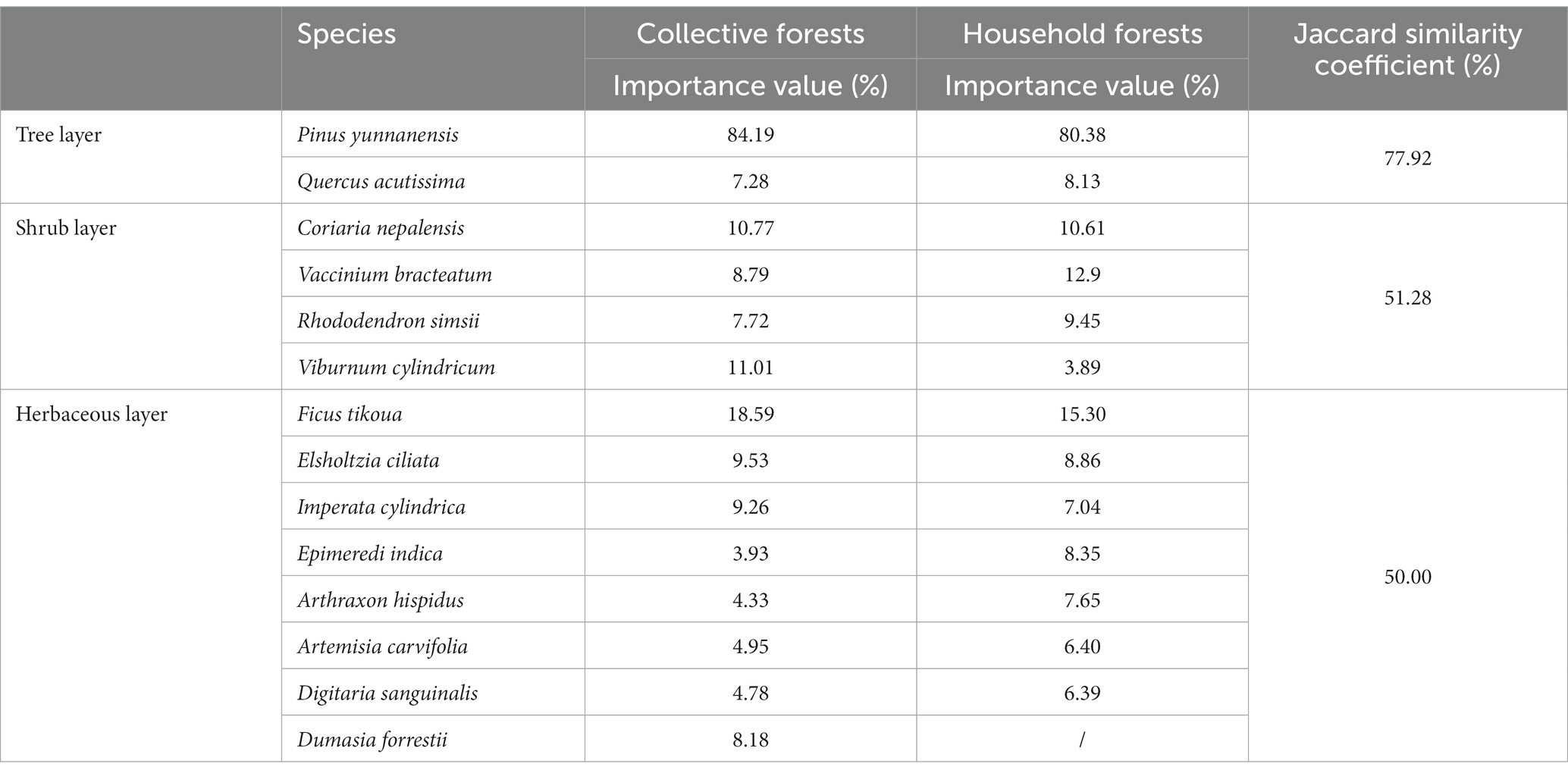
Table 3. Comparison of species composition in tree layer, shrub layer and herbaceous layer between collective forests and household forests.
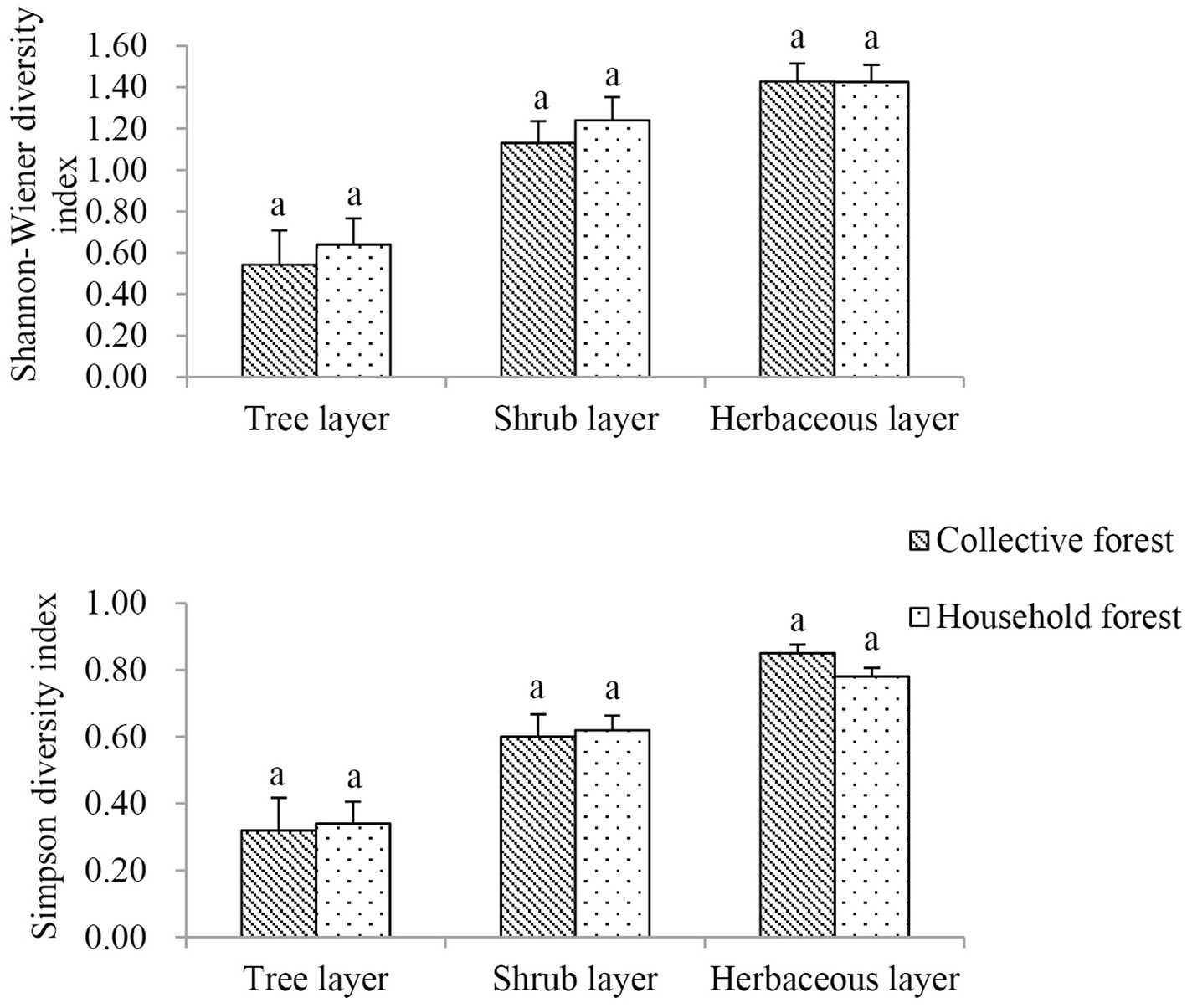
Figure 3. Comparison of Shannon-Wiener diversity index and Simpson diversity index of tree, shrub and herbaceous layers at the village community level. Samples sizes are n = 4 and 4, respectively, for collective forest and household forest groups. Error bars indicate the standard errors. Bars followed by the same letter are not significantly different at p < 0.05.
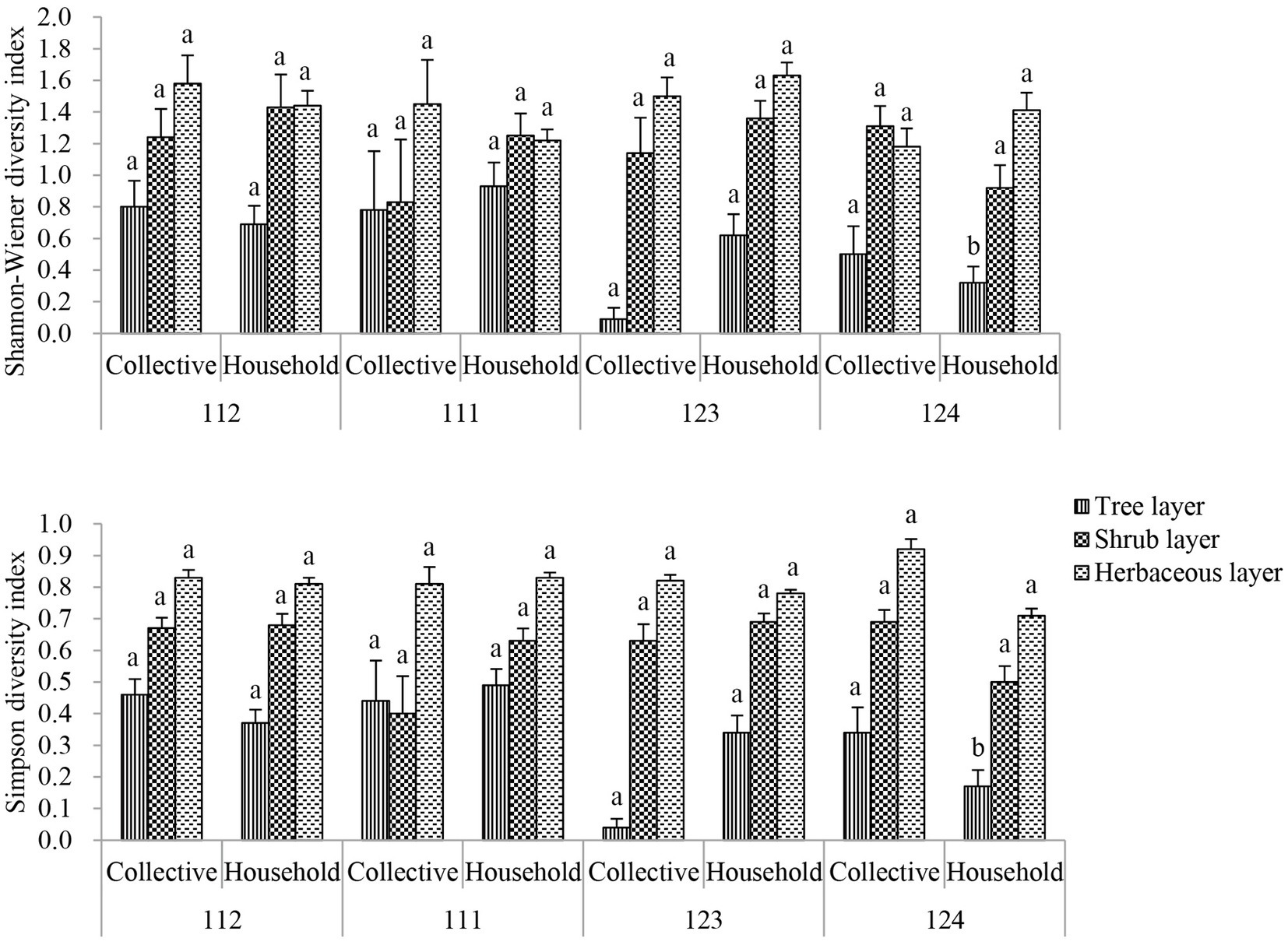
Figure 4. Comparison of Shannon-Wiener diversity index and Simpson diversity index of tree, shrub and herbaceous layers at plot level. Samples sizes are n = 6 and 24, respectively, for collective forest and household forest groups of each community. Error bars indicate the standard errors. Bars followed by the same letter are not significantly different at p < 0.05.
3.3. Aboveground biomass
At the village community level, there were no significant differences in number of trees, height, DBH/CD or aboveground biomass between the collective forests and household forests (Figure 5). At the plot level, in 75% of the village communities, collective forests had significantly higher tree height, DBH/CD and aboveground biomass than household forests, but the opposite was true for number of trees (Figure 6). In summary, tall and larger trees are commonly grown in collective forests in our study area, while household forests are populated by denser but slender, shorter trees (Figure 7).
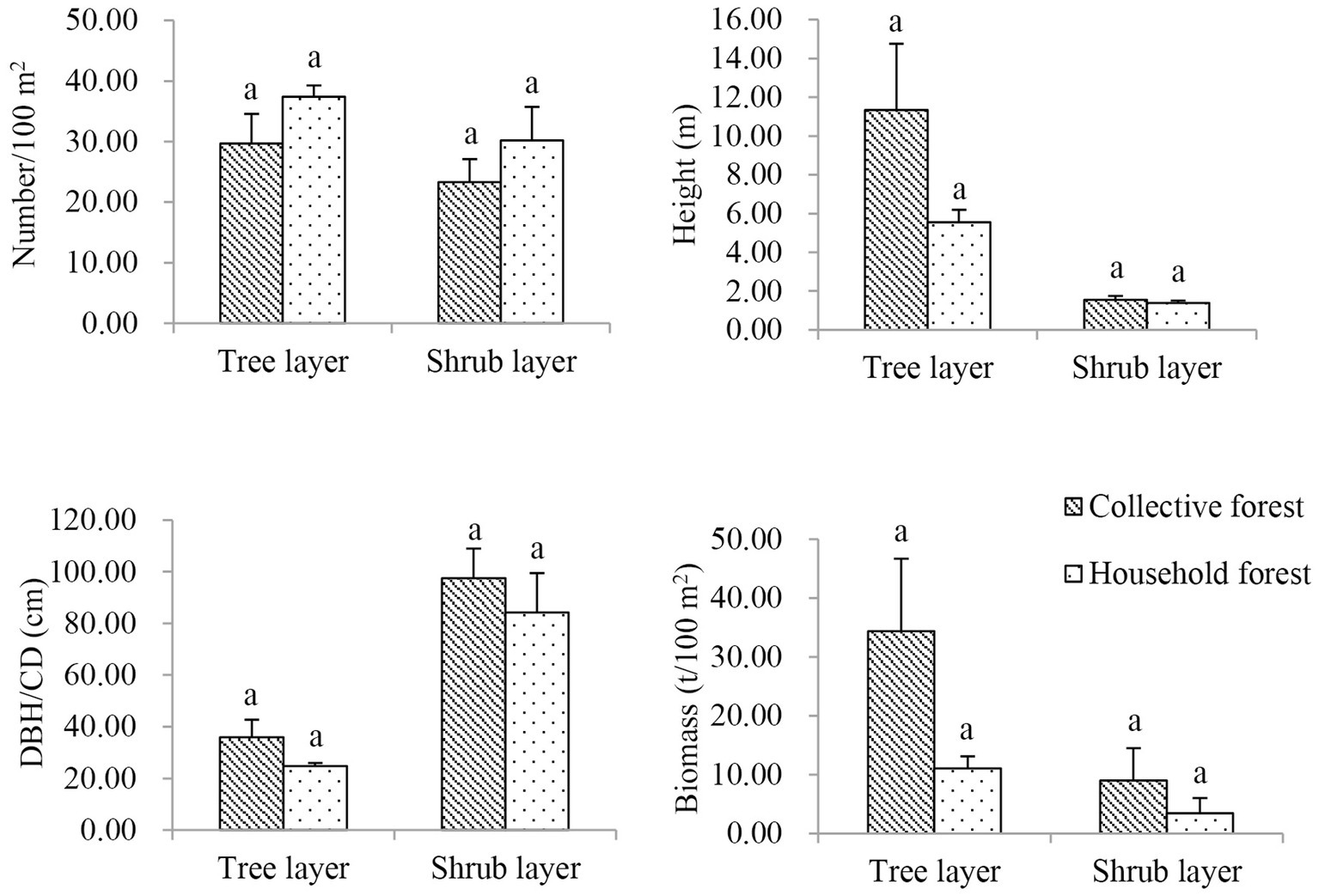
Figure 5. Comparison of number, height, DBH/CD and biomass of the tree and shrub layers at the village community level. Samples sizes are n = 4 and 4, respectively, for collective forest and household forest groups. Error bars indicate the standard errors. Bars followed by the same letter are not significantly different at p < 0.05.
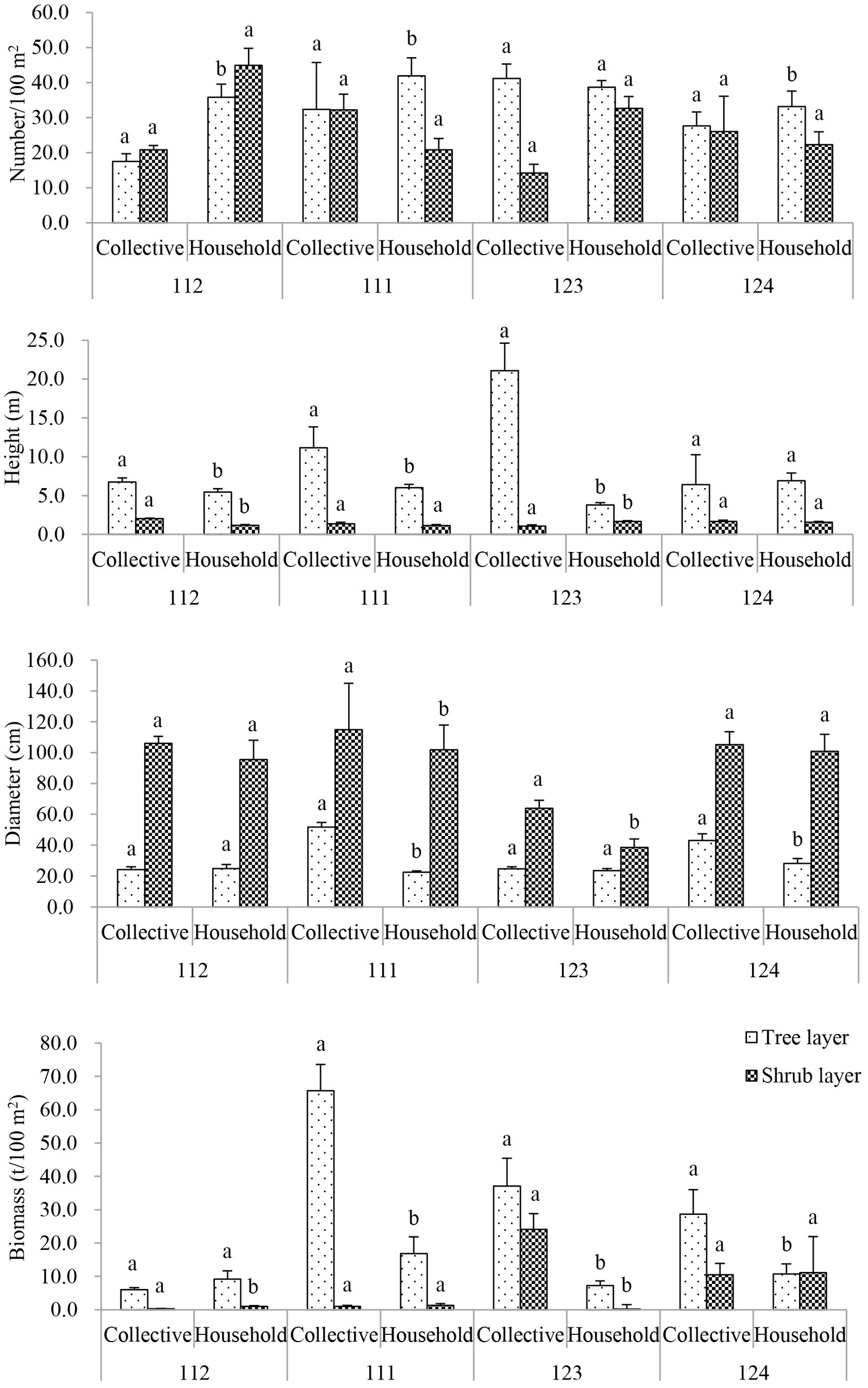
Figure 6. Comparison of number, height, diameter at breast height/crown diameter and biomass of the tree and shrub layers at plot level. Samples sizes are n = 6 and 24, respectively, for collective forest and household forest groups of each community. Error bars indicate the standard errors. Bars followed by the same letter are not significantly different at p < 0.05.
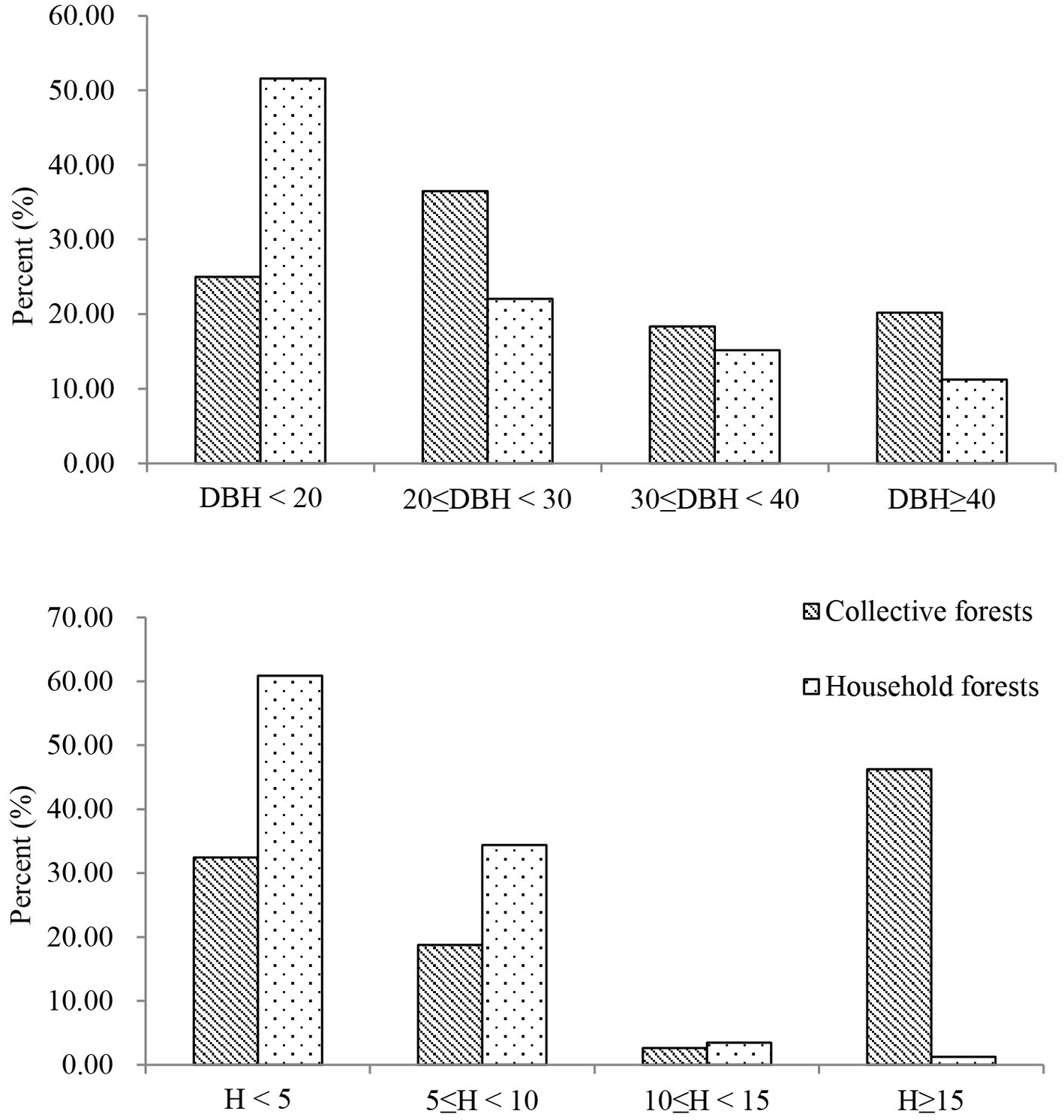
Figure 7. Comparison of tree DBH and height distribution between collective forests and household forests.
3.4. Soil fertility
There were also no significant differences in soil pH, organic matter, hydrolyzable nitrogen, available potassium, available phosphorus, total nitrogen, total phosphorus or total potassium between the collective forests and household forests at the village community level (Figure 8). In only one village community, the total nitrogen, total phosphorus and total potassium of the household forests were significantly higher than those of the collective forests at the plot level (Figure 9). These results also show that CFTR is likely to have no significant effect on forest soil fertility in the study area.
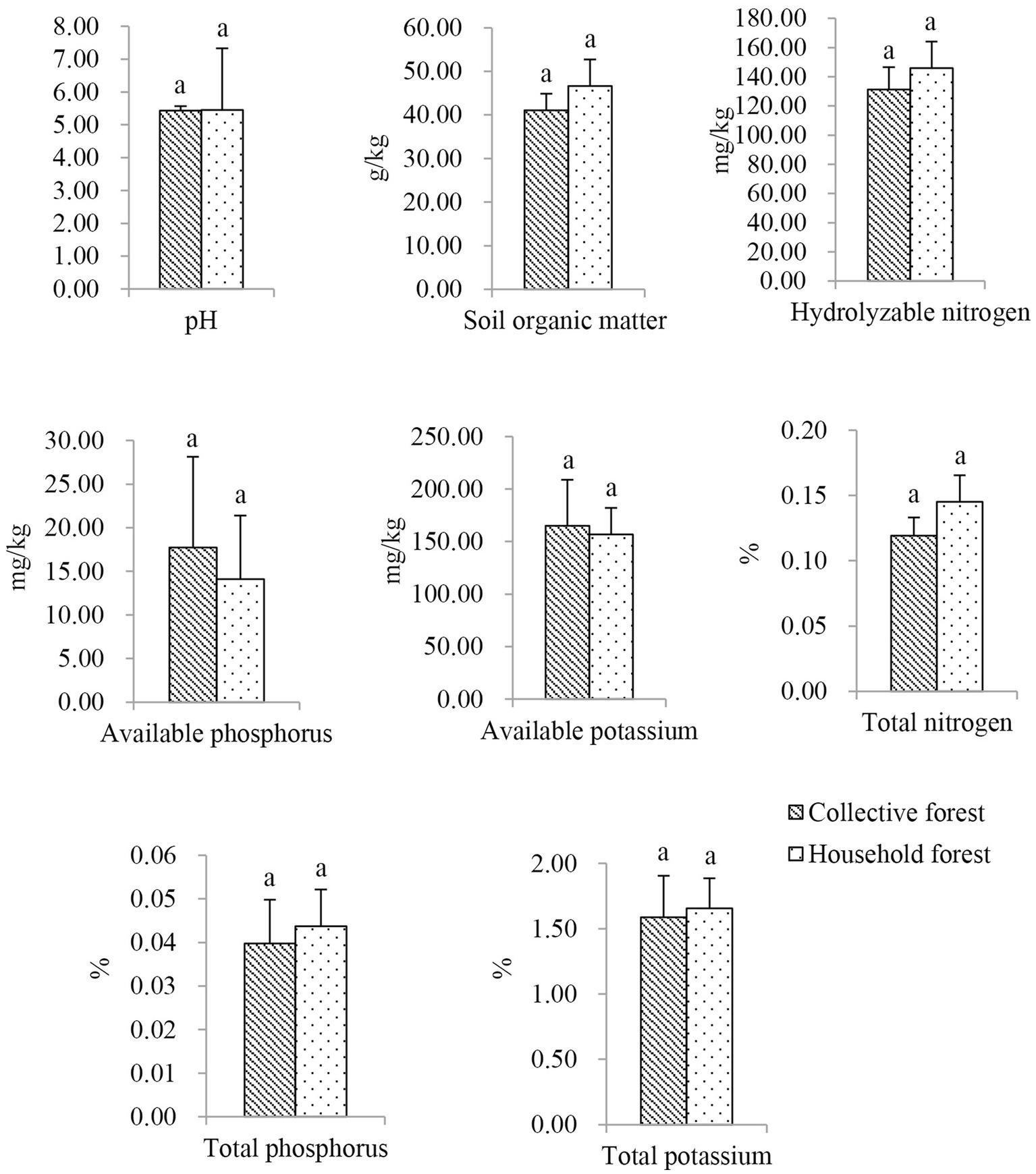
Figure 8. Comparison of pH, soil organic matter, hydrolyzable nitrogen, available phosphorus, available potassium, total nitrogen, total phosphorus and total potassium of forest community at the village community level. Samples sizes are n = 4 and 4, respectively, for collective forest and household forest groups. Error bars indicate the standard errors. Bars followed by the same letter are not significantly different at p < 0.05.
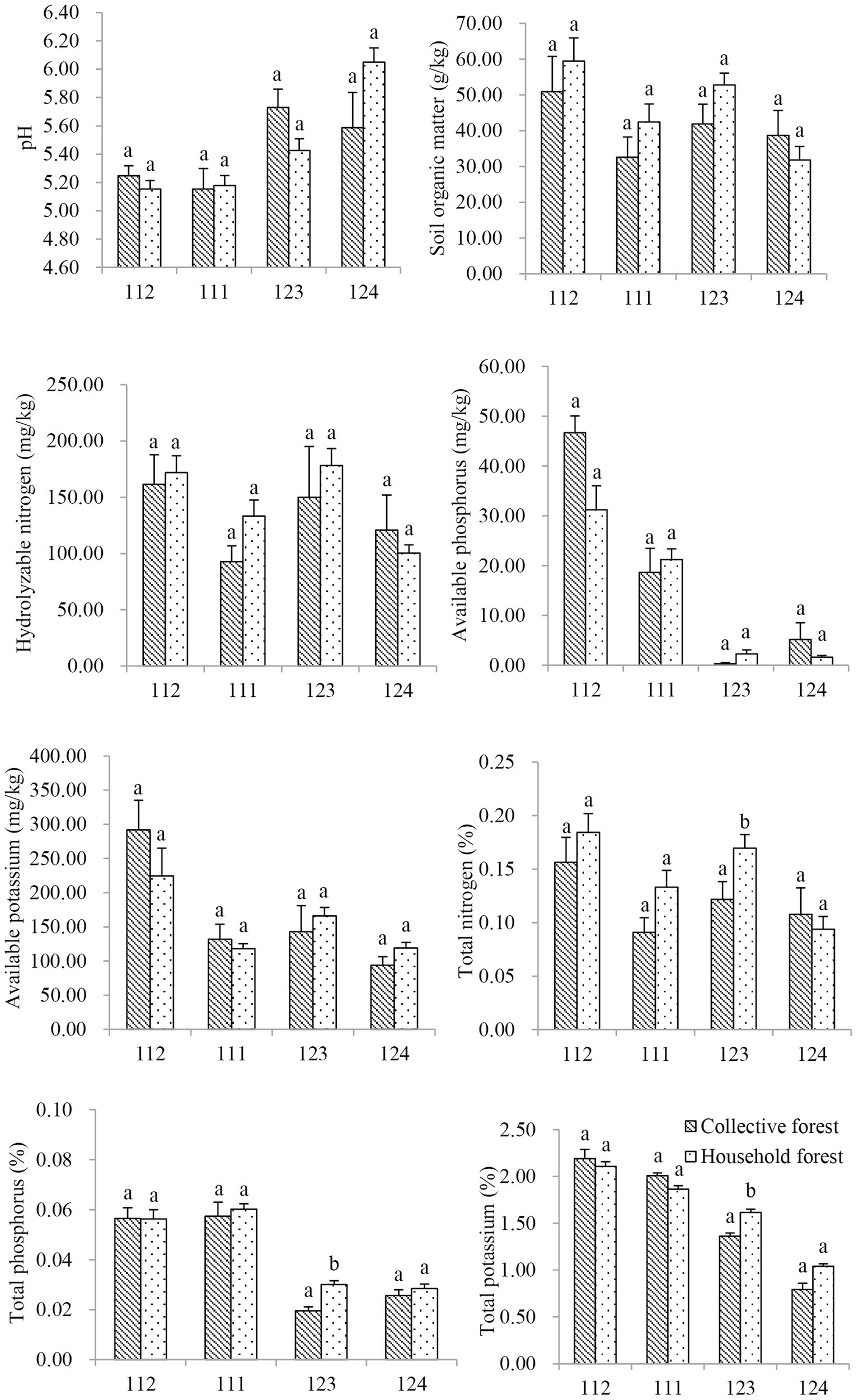
Figure 9. Comparison of pH, soil organic matter, hydrolyzable nitrogen, available phosphorus, available potassium, total nitrogen, total phosphorus and total potassium of forest community at plot level. Samples sizes are n = 6 and 24, respectively, for collective forest and household forest groups of each community. Error bars indicate the standard errors. Bars followed by the same letter are not significantly different at p < 0.05.
3.5. Socioeconomic observations
Policy enforcement rules, forest managers and ecological compensation are designed to improve forest conditions by improving the way households utilize forests. Quantitative data from household questionnaires and qualitative data from focus group discussions were used to summarize socioeconomic observations in the four communities. Stabilizing forests and communities was the main focus of CFTR implementation in the mountain hinterlands. In almost all households surveyed, community residents may collect nontimber forest products (pine needles, mushrooms and medicinal plants) in both the collective forests and household forests at their discretion. Firewood, including dry wood and miscellaneous wood, is exclusively allowed to be collected freely in household forests. Pine tree harvesting was formally prohibited in the collective forests. There is a significant difference in the harvesting weight of firewood and wood between the surveyed households in collective forests and household forests. On average, household members in households forests harvested a higher weight of firewood and wood compared to households in collective forests (Table 4). Every household in the study area was eligible for forest ecological compensation annually after CFTR was implemented. Annual payments vary from 50 to 390 yuan/household, accounting for 0.50–8.96% of the total household income in 2013 (Table 5).

Table 4. Comparison of harvesting weight of firewood and wood for surveyed households between collective forests and household forests in 2013 (Samples sizes are n = 104 and 104, respectively, for collective forests and household forests groups).
4. Discussion
Our results show an overall trend of increasing forest cover that could be interpreted as successful forest expansion policies. There were no significant differences in plant diversity or soil fertility between collective forests and household forests. Moreover, the aboveground biomass of collective forests was significantly higher than that of household forests. Based on all the above findings, CFTR likely does not account for the variation in community-level forest conditions in the study area. The large number of different ethnic groups in China, which have different institutions and different rates of population growth and market development, and the inherent climate, ecological differences, and the extent to which formal government can influence local tenure arrangements are all possible reasons for the variation observed (Place, 2009). The redistribution of rights to forestland affects hundreds of millions of people who depend on it as a source of livelihood. It is not surprising that CFTR shows uneven performance. Policy prescriptions often have tensions with each other and with local practices, which lead to different and creative local implementation strategies (Lind-Riehl et al., 2015). The impacts of CFTR on community-scale forest conditions in the study area are thus likely to be closely related to its differentiated local implementation.
4.1. Relationship between CFTR implementation and local-scale forest conditions from socioeconomic evidence
In the past four decades, Chinese state authorities have launched a series of payments for environmental services (PES) projects to promote forest transition, typically represented by CFTR and RFFP (Delang and Wang, 2013; Liu et al., 2016; Hua et al., 2018b). Forest cover is the “hard” policy component that is used to quantify official performance, while plant diversity, soil fertility and biomass are the “soft” policy components that evade quantitative and systematic assessment. As politically appointed officials, senior administrative officials at the national, provincial and even municipal levels are more concerned with the coming years than with longer-term goals, resulting in excessive indulgence in expanding afforestation areas and reforestation (Yin et al., 2013). This is probably the key reason for the increases in cover of both collective and household forests in the study area. Most studies of PES projects have also shown a positive correlation between payments and forest cover (Min-Venditti et al., 2017). From 1982 to 2016, the total area covered by trees globally increased by 224 × 104 km2 (Song et al., 2018). The recent expansion of planted forests, mainly in temperate regions, has resulted in a decline in net forest loss (Kohl et al., 2015; Song et al., 2018; Zhang, 2019). This could frame global forest trends in the optimism of forest transition (Walker, 2021). We also found evidence of local loss in forest cover. From 2006 to 2011, the Comfortable Housing Program project was implemented in community 123, and households were supported in building new houses. More than 40 respondents said the building boom was responsible for the cut down of almost all large trees. The NDVI index of collective forests and household forests declined sharply in 2010 (Figure 2C). After that, timber regulations were reinstated. The end of the building boom and the current reduction in timber requirements for new homes allowed forests to recover, as evidenced by an increase in the NDVI for forests in 2014 (Figure 2C). Nearly 50% of China’s collective forests are natural forests (Hua et al., 2018b). Further expansion of planted forests in the future is unlikely due to pressures from economic development, urbanization, environmental protection and land suitability, and a key element of management strategy is to radically improve how existing forests are managed (Hou et al., 2019).
Regarding the impact of CFTR, the surveyed residents were concerned about forest guarding, logging restrictions and ecological compensation rather than possible access rights changes due to changes in land use rights. At any of the study sites, residents were free to collect non-timber forest products (pine needles, mushrooms, medicinal plants and bamboo poles) in their own and others’ household forests or collective forests as long as the trees were not destroyed (Table 5). Pine trees are both the subject of state restrictions and surveillance, and they serve as a major source of firewood, which is vital in the daily lives of households in the study area. Local forestry officials began banning the cutting of pine trees after CFTR was implemented. Each community has employed forest rangers who are responsible for patrolling the community forests, implementing forest rules and overseeing forestry programs. However, the focus of CFTR in the region is on “stabilizing forests and communities,” and rather than imposing tenure designs, local authorities are implementing loose buffers (Colchester, 2002; Zinda and Zhang, 2018; He et al., 2020). In practice, forest managers and rangers practice leniency, allowing residents to collect the firewood they need from household forests. Dead or fallen trees and shrubs, except protected plants, can be collected at will in household forests (Table 4). Signs of deforestation—piles of wood, tree stumps and pine bark cut open for firewood—can be found in each household forest in the study area. Moreover, many households have planted walnut trees in household forests, as well as a few chestnut and other fruit trees. As long as the surveyed plot is a walnut forest, households can obtain material and economic benefits from it. Residents fear that if successors replace the trees with native vegetation, they will be reclassified as collective forests. In the field survey of forest plots, we found many walnut seedlings in most household forest plots. In questionnaires and focus group interviews, households stated that to make walnut trees grow faster and healthier, they would apply chemical and compound fertilizers to walnut trees planted in household forests. These fertilizers were given away free by the government to encourage the planting of walnuts, a tree that has both ecological and economic benefits (Zinda and He, 2020). Chemical fertilizers and compound fertilizers are rich in nitrogen, phosphorus, potassium and other elements, which may be an important reason why the soil fertility of household forests was higher than that of collective forests in some communities. Most of the local households interviewed also grazed their livestock (e.g., pigs, cattle, goats and sheep) in the household forests, although they were aware of the degradation these activities caused to canopy density and tree size. P. yunnanensis was the dominant and common species in both the household and collective forest plots studied (Table 3). The concern for P. yunnanensis in forest management indicates the extended concern for pine trees. To promote pine growth, residents were called in to trim the lower and curved branches of pine trees in the collective forests. These actions show that local forestry stations are managing forests with the goal of cultivating straight and larger trees. Restrictions on pine trees and firewood harvesting and grazing access in collective forests probably led to the general growth of tall, large trees with higher aboveground biomass, while extreme disturbances from forest use activities resulted in the general growth of dense but slender, shorter trees in household forests (Table 4 and Figure 6). The policy’s single-minded focus on certain types of trees neglects other parts of the forest. The degradation of household forests is likely to have adversely affected forest dynamics and associated biodiversity, ecological functions and ecosystem services over time (Jameson and Ramsay, 2007).
Economic compensation is the key to better promoting sustainable forest management among rural households in China (Liu et al., 2017a). In southeastern China, the devolution of forest management to individual households has had a high impact on poverty reduction, with increased incomes and improved quality of life (Chen and Innes, 2013). Once households have enough income, they pay more attention to ecological well-being. The economic returns of household forests in the study area are mainly the compensation paid for forest ecological benefits. The logic of forest ecological compensation echoes that of PES and is increasingly popular in international environmental management (Muradian et al., 2010). The household share of collective forest compensation rights is fixed at 70 years. Local forestry agents responded to the challenges of forest boundary demarcation and forest access by allocating ecological compensation payments based on household size. Annual payments range from 25 yuan/person (50–70 yuan/household) in the most populous village to 390 yuan/household in the ridge village with the largest collective forest area (Table 5). Most of the interviewed households indicated that the compensation amount was too small to be an effective incentive for them to actively manage household forests. The precondition for forest compensation payments should be effective forest management. However, no one we interviewed could recall these forest compensation payments being withheld if forest management failed. Accordingly, the small amount of forest compensation and the very loose terms of compensation payments are also the key reasons that CFTR does not have a significant effect on forest conditions at the community scale.
4.2. Reflection of the CFTR
Policy is the primary tool that society can use to change outcomes, but we lack information on the conditions that lead to successful policies. Strong rights can improve forest conditions and livelihoods only with multidimensional support (Gilmour, 2016; Katila et al., 2020b). Studies on CFTR to date have found mixed results (Archibald et al., 2009; Zhang et al., 2012; Xie et al., 2013; Xu and Hyde, 2019; He et al., 2020). The options set out in the CFTR policy statement clearly state that village communities have the right to flexibility in implementing collectivized arrangements. There are differences in the extent and duration of household or collective arrangements. Qin et al. (2011) found that households were very concerned about the type of rights provided by the contract and only considered the land as their own when the forestland tenure was as long as 75 years. Moreover, the economic benefits and the degree of promotion of the forest rights market circulation were uneven in the case of forestland parcelization (Xie et al., 2014). In some areas, timber markets monopolized by local traders and lack of access to wood quotas prevent households from investing in better forest management (Siikamäki et al., 2015). Full logging rights for standing trees and relaxation of restrictions on logging quotas would have a positive impact on forestry investment (Lin et al., 2020). Of all forest resources, wood is most tightly controlled by national authorities. Homeowners building houses must submit a proposal for approval by the township forestry agency stating the amount and location of harvested timber in the study area (Table 5). Only a certain number of households were allowed to build houses every year. It is still difficult for most local households to obtain harvest quotas. Households are unable to realize benefits from household forests, although they have secure forest rights (He, 2016). Well-designed mechanisms are needed for forest investments in sustainable forest management. It is crucial to take into account local management practices, community participation, and institutional arrangements when promoting sustainable forest management.
Policymakers need to be cautious about the large body of evidence of the positive impact of CFTR. The discrepancy between the officially assigned tenure and the actual practice of rural residents and officials stems from the local government’s response to the need to generate policy output while avoiding social chaos. CFTR and a series of supporting measures did not encourage rural households in the study area to invest more in forestry, most likely because of the lack of adequate financial support and institutionalized enforcement rules. It is necessary to further analyze the interaction between different policies and between policies and background variables, such as government capacity, property rights systems and biophysical conditions (Min-Venditti et al., 2017). Context-specific approaches are critical to provide smallholder, indigenous and local communities with the right to use, manage and benefit from forest resources and to participate meaningfully in decision-making involving these rights (Katila et al., 2020b). Decision-makers should encourage a diversified approach to forest management, taking into account the specific needs and characteristics of different regions. Attempts to formalize forest tenure rights must be flexible enough and adapted to the local environment so that changes induced by the CFTR can improve and benefit from local access to forest resources.
4.3. Limitation
Due to the use of cross-sectional data, it is not possible to completely eliminate the potential for selection effects on forest conditions or capture long-term dynamics. Although the confounding biophysical influences were minimized (sunlight and precipitation), and the comparisons of NDVI prior to the new round of CFTR in 2003 showed no significant differences were observed between collective forests and household forests groups (Table 2). Not directly selecting natural villages with and without CFTR implementation for comparison may lead to certain limitations. Regional sampling and small geographical coverage limits our assertive claims about how CFTR and related socioeconomic processes play out in other regions and on a larger scale. In the future, we plan to incorporate permanent sample plots or conduct longitudinal studies to gain a more comprehensive understanding of the long-term impacts of management practices on forest conditions. Broadening the geographical coverage and incorporating a greater variety of study sites would enhance the applicability of the findings. These methods will allow for a better elucidation of temporal dynamics and the establishment of causal relationships. We hope that the insights from this study will help clarify these crucial links between CFTR policy implementation and change in coupled human and natural systems.
5. Conclusion
Overall, our findings suggest that the devolution of forest management and use rights from community collectives to individual households in CFTR may not have fully achieved the improvements in local-scale forest conditions expected by the government. Differentiated access and use, low forest ecological compensation standards and loose compensation payment conditions were likely the key reasons affecting forest conditions in the study area. Strengthening and formalizing households’ de facto rights over forestland under the premise of effective forest management is of great significance for the successful implementation of CFTR in the region.
Land management programs target different sectors of the landscape, but their impacts are tightly connected through livelihood activities. Different forest owners may have different goals in managing their forest properties. Many rural households benefit from the increase in forestry income from CFTR, but it also causes forest fragmentation (Liu et al., 2017a). Forest fragmentation is an important cause of biodiversity loss (Betts et al., 2017; Chase et al., 2020). The impact of CFTR on forest fragmentation is also an important future research direction. To enrich and deepen the understanding of CFTR, larger-scale and longer-term empirical studies should be conducted in the future.
Data availability statement
The original contributions presented in the study are included in the article/supplementary material, further inquiries can be directed to the corresponding authors.
Ethics statement
The current case report was exempt from the need for local ethics committee approval and informed consent, on the basis of the anonymous and noninvasive study design. Names of all places and individuals are pseudonyms, and all communities are represented by numeric codes in the manuscript. We collected retrospective socio-economic data on household involvement in CFTR and utilization of forest resources through household surveys and focus group discussions in the study area. Therefore, ethics approval or specific consent procedures were not required for this study (Li et al., 2019, 2022).
Author contributions
WL: data curation, formal analysis, investigation, methodology, visualization, writing original draft, review, and editing. JC: conceptualization, data curation, methodology, software, validation, writing original draft, review, and editing. FW: formal analysis, methodology, and visualization. ZZ: conceptualization, investigation, project administration, review, and editing. All authors contributed to the article and approved the submitted version.
Funding
This study was supported by the National Natural Science Foundation of China (No. 32301587) and the Second Tibetan Plateau Scientific Expedition and Research program (No. 2019QZKK0308).
Conflict of interest
The authors declare that the research was conducted in the absence of any commercial or financial relationships that could be construed as a potential conflict of interest.
Publisher’s note
All claims expressed in this article are solely those of the authors and do not necessarily represent those of their affiliated organizations, or those of the publisher, the editors and the reviewers. Any product that may be evaluated in this article, or claim that may be made by its manufacturer, is not guaranteed or endorsed by the publisher.
References
Archibald, S., Roy, D. P., Van Wilgen, B. W., and Scholes, R. J. (2009). What limits fire? An examination of drivers of burnt area in Southern Africa. Glob. Chang. Biol. 15, 613–630. doi: 10.1111/j.1365-2486.2008.01754.x
Balooni, K., Ballabh, V., and Inoue, M. (2007). Declining instituted collective management practices and forest quality in the Central Himalayas. Econ. Polit. Wkly. 42, 1443–1452.
Betts, M. G., Wolf, C., Ripple, W. J., Phalan, B., Millers, K. A., Duarte, A., et al. (2017). Global forest loss disproportionately erodes biodiversity in intact landscapes. Nature 547, 441–444. doi: 10.1038/nature23285
Blackman, A., and Veit, P. (2018). Titled Amazon indigenous communities cut forest carbon emissions. Ecol. Econ. 153, 56–67. doi: 10.1016/j.ecolecon.2018.06.016
Brown, M. (2020). Diversity and adaptation in local forest governance in Yunnan, China. Hum. Ecol. 48, 253–265. doi: 10.1007/s10745-020-00149-1
Chase, J. M., Blowes, S. A., Knight, T. M., Gerstner, K., and May, F. (2020). Ecosystem decay exacerbates biodiversity loss with habitat loss. Nature 584, 238–243. doi: 10.1038/s41586-020-2531-2
Chen, J., and Innes, J. L. (2013). The implications of new forest tenure reforms and forestry property markets for sustainable forest management and forest certification in China. J. Environ. Manag. 129, 206–215. doi: 10.1016/j.jenvman.2013.07.007
Colchester, M. (2002). Community forestry in Yunnan (China): the challenge for networks. Center for International Forestry Research: Bogor, Indonesia.
Curtis, P. G., Slay, C. M., Harris, N. L., Tyukavina, A., and Hansen, M. C. (2018). Classifying drivers of global forest loss. Science 361, 1108–1111. doi: 10.1126/science.aau3445
Dai, F., Shi, D., and Dai, J. (2012). The analysis on the collective forest property rights institution reform with game theory. Proceedings of the 2nd International Conference on Consumer Electronics, Communications and Networks (Yichang, China: CECNet). pp. 634–636. IEEE.
Davis, L., Johnson, K., Howard, T., and Bettinger, P. (2001). Forest management. McGraw-Hill: New York.
Delang, C. O., and Wang, W. (2013). Chinese forest policy reforms after 1998: the case of the natural forest protection program and the slope land conversion program. Int. For. Rev. 15, 290–304. doi: 10.1505/146554813807700128
Ekanayake, E. M. B. P., Cirella, G. T., and Xie, Y. (2020). Impacts of community forestry on forest condition: evidence from Sri Lanka’s intermediate zone. PLoS One 15:e0239405. doi: 10.1371/journal.pone.0239405
Fischer, R., Taubert, F., Mueller, M. S., Groeneveld, J., Lehmann, S., Wiegand, T., et al. (2021). Accelerated forest fragmentation leads to critical increase in tropical forest edge area. Sci. Adv. 7:eabg7012. doi: 10.1126/sciadv.abg7012
Frayer, J., Sun, Z., Müller, D., Munroe, D. K., and Xu, J. (2014). Analyzing the drivers of tree planting in Yunnan, China, with Bayesian networks. Land Use Policy 36, 248–258. doi: 10.1016/j.landusepol.2013.08.005
Gilmour, D. (2016). Forty years of community-based forestry: a review of its extent and effectiveness, In FAO forestry paper. Food and Agriculture Organization of the United Nations (FAO): Italy.
Gotelli, N. J., and Chao, A. (2013). Measuring and estimating species richness, species diversity, and biotic similarity from sampling data. Encycloped. Biodivers. 5, 195–211. doi: 10.1016/B978-0-12-384719-5.00424-X
Guo, M., Li, J., He, H., Xu, J., and Jin, Y. (2018). Detecting global vegetation changes using Mann-Kendal (MK) trend test for 1982–2015 time period. Chin. Geogr. Sci. 28, 907–919. doi: 10.1007/s11769-018-1002-2
He, J. (2016). Rights to benefit from forest? A case study of the timber harvest quota system in Southwest China. Soc. Nat. Resour. 29, 448–461. doi: 10.1080/08941920.2015.1062949
He, J., Kebede, B., Martin, A., and Gross-Camp, N. (2020). Privatization or communalization: a multi-level analysis of changes in forest property regimes in China. Ecol. Econ. 174:106629. doi: 10.1016/j.ecolecon.2020.106629
He, J., Lang, R., and Xu, J. C. (2014). Local dynamics driving forest transition: insights from upland villages in Southwest China. Forests 5, 214–233. doi: 10.3390/f5020214
He, J., and Sikor, T. (2017). Looking beyond tenure in China's collective forest tenure reform: insights from Yunnan province, Southwest China. Int. For. Rev. 19, 29–41. doi: 10.1505/146554817820888609
Holden, S., Xu, J., and Jiang, X., (2011). Collective versus individual property: tenure security and forest tenure reforms in China. Centre for Land Tenure Studies Working Paper No. 04/11. Oslo, Norway: Centre for Land Tenure Studies, Norwegian University of Life Sciences.
Hou, J., Yin, R., and Wu, W. (2019). Intensifying Forest Management in China: what does it mean, why, and how? Forest Policy Econ. 98, 82–89. doi: 10.1016/j.forpol.2017.10.014
Hua, F. Y., Wang, L., Fisher, B., Zheng, X. L., Wang, X. Y., Yu, D. W., et al. (2018a). Tree plantations displacing native forests: the nature and drivers of apparent forest recovery on former croplands in southwestern China from 2000 to 2015. Biol. Conserv. 222, 113–124. doi: 10.1016/j.biocon.2018.03.034
Hua, F. Y., Xu, J. C., and Wilcove, D. S. (2018b). A new opportunity to recover native forests in China. Conserv. Lett. 11, 1–8. doi: 10.1111/conl.12396
Huang, W. (2019). Forest condition change, tenure reform, and government-funded eco-environmental programs in Northeast China. Forest Policy Econ. 98, 67–74. doi: 10.1016/j.forpol.2018.09.003
Huang, W., Duan, W., Nover, D., Sahu, N., and Chen, Y. (2021). An integrated assessment of surface water dynamics in the Irtysh River Basin during 1990–2019 and exploratory factor analyses. J. Hydrol. 593:125905. doi: 10.1016/j.jhydrol.2020.125905
Jameson, J. S., and Ramsay, P. M. (2007). Changes in high-altitude Polylepis forest cover and quality in the cordillera de Vilcanota, Perú, 1956–2005. Biol. Conserv. 138, 38–46. doi: 10.1016/j.biocon.2007.04.008
Katila, P., Colfer, C.J.P., De Jong, W., Galloway, G., Pacheco, P., and Winkel, G. (2020a). Sustainable development goals: their impacts on forests and people. Cambridge University Press: Cambridge.
Katila, P., McDermott, C., Larson, A., Aggarwal, S., and Giessen, L. (2020b). Forest tenure and the sustainable development goals – a critical view. Forest Policy Econ. 120:102294. doi: 10.1016/j.forpol.2020.102294
Kohl, M., Lasco, R., Cifuentes, M., Jonsson, O., Korhonen, K. T., Mundhenk, P., et al. (2015). Changes in forest production, biomass and carbon: results from the 2015 UN FAO global Forest resource assessment. For. Ecol. Manag. 352, 21–34. doi: 10.1016/j.foreco.2015.05.036
Larson, A. M., Barry, D., and Dahal, G. R. (2010). New rights for forest-based communities? Understanding processes of forest tenure reform. Int. For. Rev. 12, 78–96. doi: 10.1505/ifor.12.1.78
Lawry, S., Samii, C., Hall, R., Leopold, A., Hornby, D., and Mtero, F. (2017). The impact of land property rights interventions on investment and agricultural productivity in developing countries: a systematic review. J. Dev. Effect. 9, 61–81. doi: 10.1080/19439342.2016.1160947
Li, X. N. (2010). Allometry of understory tree species in a natural secondary forest in Northeast China. Sci. Silvae Sin. 46, 22–32. doi: 10.11707/j.1001-7488.20100804
Li, W., Chen, J., and Zhang, Z. (2020). Forest quality-based assessment of the returning farmland to forest program at the community level in SW China. For. Ecol. Manag. 461:117938. doi: 10.1016/j.foreco.2020.117938
Li, W., Wang, W., Chen, J., and Zhang, Z. (2022). Assessing effects of the returning farmland to forest program on vegetation cover changes at multiple spatial scales: the case of Northwest Yunnan, China. J. Environ. Manag. 304:114303. doi: 10.1016/j.jenvman.2021.114303
Li, W., Zinda, J. A., and Zhang, Z. (2019). Does the “returning farmland to forest program” drive community-level changes in landscape patterns in China? Forests 10:933. doi: 10.3390/f10100933
Lin, Y., Qu, M., Liu, C., and Yao, S. (2020). Land tenure, logging rights, and tree planting: empirical evidence from smallholders in China. China Econ. Rev. 60:101215. doi: 10.1016/j.chieco.2018.08.011
Lind-Riehl, J., Jeltema, S., Morrison, M., Shirkey, G., Mayer, A. L., Rouleau, M., et al. (2015). Family legacies and community networks shape private forest management in the western Upper Peninsula of Michigan (USA). Land Use Policy 45, 95–102. doi: 10.1016/j.landusepol.2015.01.005
Liu, L. S. (2015). Regression analysis of biomass model of Pinus yunnanensis in Northwest Yunnan. J. Shandong For. Sci. Technol. 4, 5–9.
Liu, J., Coomes, D. A., Gibson, L., Hu, G., Liu, J., Luo, Y., et al. (2019). Forest fragmentation in China and its effect on biodiversity. Biol. Rev. 94, 1636–1657. doi: 10.1111/brv.12519
Liu, Y., Li, Z., Chen, Y., Li, Y., Li, H., Xia, Q., et al. (2022). Evaluation of consistency among three NDVI products applied to High Mountain Asia in 2000–2015. Remote Sens. Environ. 269:112821. doi: 10.1016/j.rse.2021.112821
Liu, P., and Ravenscroft, N. (2016). Collective action in China’s recent collective forestry property rights reform. Land Use Policy 59, 402–411. doi: 10.1016/j.landusepol.2016.09.011
Liu, C., Wang, S., and Liu, H. (2017a). An examination of the effects of recent tenure reforms in China's collective forests on peasants' forest activities and their income. Int. For. Rev. 19, 55–67. doi: 10.1505/146554817820888672
Liu, C., Wang, S., Liu, H., and Zhu, W. (2017b). Why did the 1980s' reform of collective forestland tenure in southern China fail? Forest Policy Econ. 83, 131–141. doi: 10.1016/j.forpol.2017.07.008
Liu, P., Yin, R., and Li, H. (2016). China's forest tenure reform and institutional change at a crossroads. Forest Policy Econ. 72, 92–98. doi: 10.1016/j.forpol.2016.06.019
Luan, W. J. (1989). Studies on the biomass and calorific value of chinese coriaria (coriaria sinica maxim) fuelwood in hilly land of South Gansu. J. Gansu Agric. Univ. 4, 77–82.
Luo, Y. J., Wang, X. K., Ouyang, Z. Y., Lu, F., Feng, L. G., and Tao, J. (2020). A review of biomass equations for China's tree species. Earth Syst. Sci. Data 12, 21–40. doi: 10.5194/essd-12-21-2020
Luo, Y. J., Zhang, X. Q., Wang, X. K., and Lu, F. (2014). Biomass and its allocation of Chinese forest ecosystems. Ecology 95:2026. doi: 10.1890/13-2089.1
Min-Venditti, A. A., Moore, G. W., and Fleischman, F. (2017). What policies improve forest cover? A systematic review of research from Mesoamerica. Glob. Environ. Chang. 47, 21–27. doi: 10.1016/j.gloenvcha.2017.08.010
Morreale, L. L., Thompson, J. R., Tang, X., Reinmann, A. B., and Hutyra, L. R. (2021). Elevated growth and biomass along temperate forest edges. Nat. Commun. 12:7181. doi: 10.1038/s41467-021-27373-7
Muradian, R., Corbera, E., Pascual, U., Kosoy, N., and May, P. H. (2010). Reconciling theory and practice: an alternative conceptual framework for understanding payments for environmental services. Ecol. Econ. 69, 1202–1208. doi: 10.1016/j.ecolecon.2009.11.006
Nichiforel, L., Keary, K., Deuffic, P., Weiss, G., Thorsen, B. J., Winkel, G., et al. (2018). How private are Europe’s private forests? A comparative property rights analysis. Land Use Policy 76, 535–552. doi: 10.1016/j.landusepol.2018.02.034
Pan, W. C., Li, L. C., Gao, Z. H., Zhang, X. Q., and Tang, D. Y. (1978). The biomass and productivity of Chinese fir plantations. Hunan For. Sci. Technol. 5, 1–12.
Paul, K. I., Roxburgh, S. H., Chave, J., England, J. R., Zerihun, A., Specht, A., et al. (2016). Testing the generality of above-ground biomass allometry across plant functional types at the continent scale. Glob. Chang. Biol. 22, 2106–2124. doi: 10.1111/gcb.13201
Place, F. (2009). Land tenure and agricultural productivity in Africa: a comparative analysis of the economics literature and recent policy strategies and reforms. World Dev. 37, 1326–1336. doi: 10.1016/j.worlddev.2008.08.020
Qin, P., Carlsson, F., and Xu, J. (2011). Forest tenure reform in China: a choice experiment on farmers’ property rights preferences. Land Econ. 87, 473–487. doi: 10.3368/le.87.3.473
Rahman, M. R., Islam, A., and Rahman, M. A. (2004). NDVI derived sugarcane area identification and crop condition assessment. Plan Plus 1, 1–12.
Rendenieks, Z., Nikodemus, O., and Brūmelis, G. (2015). The implications of stand composition, age and spatial patterns of forest regions with different ownership type for management optimisation in northern Latvia. For. Ecol. Manag. 335, 216–224. doi: 10.1016/j.foreco.2014.10.001
Riitters, K., Wickham, J., Costanza, J. K., and Vogt, P. (2016). A global evaluation of forest interior area dynamics using tree cover data from 2000 to 2012. Landsc. Ecol. 31, 137–148. doi: 10.1007/s10980-015-0270-9
Robinson, B. E., Holland, M. B., and Naughton-Treves, L. (2014). Does secure land tenure save forests? A meta-analysis of the relationship between land tenure and tropical deforestation. Glob. Environ. Chang. 29, 281–293. doi: 10.1016/j.gloenvcha.2013.05.012
Robinson, B. E., Masuda, Y. J., Kelly, A., Holland, M. B., Bedford, C., Childress, M., et al. (2018). Incorporating land tenure security into conservation. Conserv. Lett. 11:e12383. doi: 10.1111/conl.12383
Schürmann, A., Kleemann, J., Fürst, C., and Teucher, M. (2020). Assessing the relationship between land tenure issues and land cover changes around the Arabuko Sokoke Forest in Kenya. Land Use Policy 95:104625. doi: 10.1016/j.landusepol.2020.104625
Siikamäki, J., Ji, Y., and Xu, J. (2015). Post-reform forestland markets in China. Land Econ. 91, 211–234. doi: 10.3368/le.91.2.211
Sikor, T., Gritten, D., and Atkinson, J. (2013). Community forestry in Asia and the Pacific: pathway to inclusive development. The Centre of People and Forests (RECOFTC): Bangkok.
Song, X. P., Hansen, M. C., Stehman, S. V., Potapov, P. V., Tyukavina, A., Vermote, E. F., et al. (2018). Global land change from 1982 to 2016. Nature 560, 639–643. doi: 10.1038/s41586-018-0411-9
Timko, J., Le Billon, P., Zerriffi, H., Honey-Roses, J., de la Roche, I., Gaston, C., et al. (2018). A policy nexus approach to forests and the SDGs: tradeoffs and synergies. Curr. Opin. Environ. Sustain. 34, 7–12. doi: 10.1016/j.cosust.2018.06.004
Walker, K. L. (2021). Effect of land tenure on forest cover and the paradox of private titling in Panama. Land Use Policy 109:105632. doi: 10.1016/j.landusepol.2021.105632
Xie, Y., Gong, P., Han, X., and Wen, Y. (2014). The effect of collective forestland tenure reform in China: does land parcelization reduce forest management intensity? J. For. Econ. 20, 126–140. doi: 10.1016/j.jfe.2014.03.001
Xie, Y., Wen, Y., Zhang, Y., and Li, X. (2013). Impact of property rights reform on household forest management investment: an empirical study of southern China. Forest Policy Econ. 34, 73–78. doi: 10.1016/j.forpol.2012.12.002
Xu, J. (2011). China's new forests aren't as green as they seem. Nature 477:371. doi: 10.1038/477371a
Xu, J. T., and Hyde, W. F. (2019). China’s second round of forest reforms: observations for China and implications globally. Forest Policy Econ. 98, 19–29. doi: 10.1016/j.forpol.2018.04.007
Xu, J., and Jiang, X. (2019). Collective forest tenure reform in China: outcomes and implications. The World Bank Conference on Land Goverance, Guangdong. p. 88.
Xu, T., Liang, W., Li, F., and Liu, J. (2017). Forest fires and forest quality-evidence from the collective forest tenure reform. For. Econ. 9, 81–87.
Xu, J. H., Wang, M. L., Huang, Q. F., and Gong, S. F. (2011). Study on aboveground biomass model of natural individual trees of Quercus acutissima. Anhui For. Sci. Technol. 37, 3–6.
Xu, J., White, A., and Lele, U., (2010). China’s forest tenure reforms, in rights and resources initiative. Washington, DC: Rights and Resources Initiative.
Xue, J., and Su, B. (2017). Significant remote sensing vegetation indices: a review of developments and applications. J. Sensors 2017, 1–17. doi: 10.1155/2017/1353691
Yi, Y., Köhlin, G., and Xu, J. (2014). Property rights, tenure security and forest investment incentives: evidence from China’s collective Forest tenure reform. Environ. Dev. Econ. 19, 48–73. doi: 10.1017/S1355770X13000272
Yin, R. (2016). Empirical linkages between devolved tenure systems and forest conditions: an introduction to the literature review. Forest Policy Econ. 73, 271–276. doi: 10.1016/j.forpol.2016.05.010
Yin, R., Yao, S., and Huo, X. (2013). China's forest tenure reform and institutional change in the new century: what has been implemented and what remains to be pursued? Land Use Policy 30, 825–833. doi: 10.1016/j.landusepol.2012.06.010
Zhang, D. (2019). China's forest expansion in the last three plus decades: why and how? Forest Policy Econ. 98, 75–81. doi: 10.1016/j.forpol.2018.07.006
Zhang, H., Buongiorno, J., and Zhu, S.-S. (2012). Domestic and foreign consequences of China’s land tenure reform on collective forests. Int. For. Rev. 14, 349–362. doi: 10.1505/146554812802646648
Zhang, X. B., and Chen, X. (2006). Investigation on biomass of Rhododendron hybridum Hort. J. Guizhou Normal Univ. 24, 14–18. doi: 10.3969/j.issn.1004-5570.2006.01.004
Zhang, Y. G., Migliavacca, M., Penuelas, J., and Ju, W. M. (2021). Advances in hyperspectral remote sensing of vegetation traits and functions. Remote Sens. Environ. 252:112121. doi: 10.1016/j.rse.2020.112121
Zinda, J. A., and He, J. (2020). Ecological civilization in the mountains: how walnuts boomed and busted in Southwest China. J. Peasant Stud. 47, 1052–1076. doi: 10.1080/03066150.2019.1638368
Keywords: collective forest tenure system reform, forest condition, mountains of Southwest China, household management, collective management
Citation: Li W, Chen J, Wu F and Zhang Z (2023) Collective forest tenure reform and forest conditions: evidence from the social-ecological system in Southwest China. Front. For. Glob. Change. 6:1162058. doi: 10.3389/ffgc.2023.1162058
Edited by:
David Mwesigye Tumusiime, Makerere University, UgandaReviewed by:
Christopher Mawa, Makerere University, UgandaNataliya Stryamets, Swedish University of Agricultural Sciences, Sweden
Copyright © 2023 Li, Chen, Wu and Zhang. This is an open-access article distributed under the terms of the Creative Commons Attribution License (CC BY). The use, distribution or reproduction in other forums is permitted, provided the original author(s) and the copyright owner(s) are credited and that the original publication in this journal is cited, in accordance with accepted academic practice. No use, distribution or reproduction is permitted which does not comply with these terms.
*Correspondence: Jiahui Chen, Y2hlbmpoQG1haWwua2liLmFjLmNu; Zhiming Zhang, emhpbWluZ196aGFuZzc2QGhvdG1haWwuY29t
 Wenqing Li
Wenqing Li Jiahui Chen
Jiahui Chen Fengwen Wu
Fengwen Wu Zhiming Zhang1*
Zhiming Zhang1*